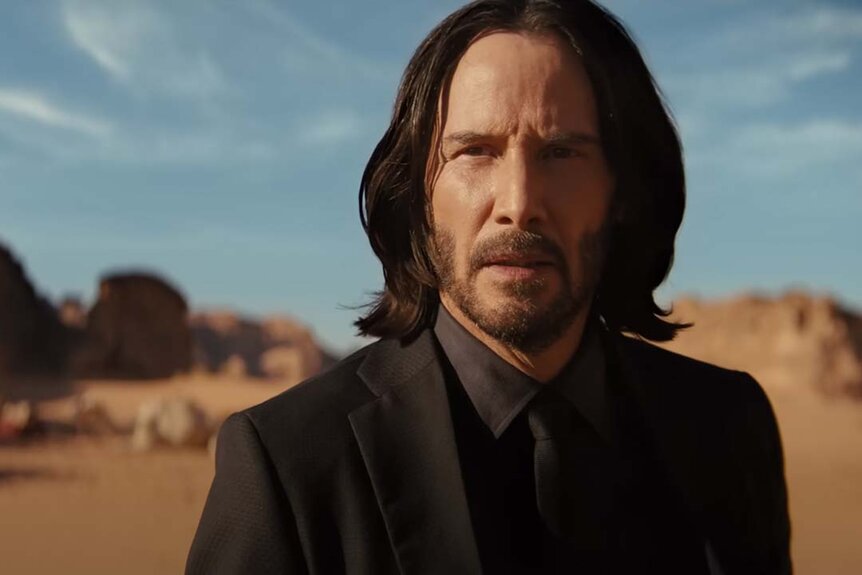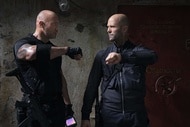Create a free profile to get unlimited access to exclusive videos, sweepstakes, and more!
'John Wick' editor talks 'Chapter 4' pacing and the 'special 3-hour edition' made just for Keanu
What ended up on the cutting room floor? Walking. Lots and lots of walking.

Film editor Nathan Orloff aptly describes the John Wick franchise as "a spiral that has gotten bigger" with each installment.
"[It] explores more territory, does more things, expands the genre of what the movie is to the point where we now have a Lawrence of Arabia reference; we have a Guardians of the Galaxy reference," he tells SYFY WIRE in the midst of a Zoom interview concerning the fourth installment in the action-heavy series directed by Chad Stahelski and fronted by Keanu Reeves.
**SPOILER WARNING! The following contains spoilers for John Wick: Chapter 4!**
The opening desert chase scene is an obvious nod to Lawrence, of course, but how do Marvel's Guardians of the Galaxy factor into the equation? To that question, Orloff replies with three words: "I am Klaus." That light-hearted sense of playfulness can be found throughout the blockbuster, allowing for a greater suspension of disbelief.
"I thought if you laughed once John jumped out of the building, your laughter makes it believable," Orloff says. "You believe that he can get up. If we cut that dramatic, let's say with more of a close-up or the music was different ... then you’d think he's dead. But if you laugh, he gets back up again. If he falls down 122 steps and you're laughing, you’re just here for the ride."
Clocking in at 2 hours and 49 minutes, the quadrilogy capper has plenty of room to stretch its legs as our favorite, suit-wearing assassin mows down scores of faceless goons in an effort to free himself from the High Table. Thanks to meticulous pacing, that lengthier runtime ended up working in the movie's favor. "It just flies by because my entire intent is around flow," Orloff notes. "That the end of every scene transitions and either launches you or perplexes you into the next scene with a specific tone and purpose."
RELATED: 'John Wick' director digs into franchise's biggest inspirations: 'These are love letters'
The version now playing in theaters was considerably shaved down from the original assembly cut, which spanned a whopping 3 hours and 45 minutes. "It was a matter of removing anything we could that was repetitive. Cutting out as many walking shots as possible," Orloff explains. "Chad loves a good walking shot and if there’s one you can’t cut out, it’s the one where it’s side-tracking Winston in the Louvre. It was about balance."
In addition to the extended walking shots, Orloff also had to nix "a little more backstory connective tissue to explain how characters got from here to there." An enthusiastic Reeves, however, wanted the movie to be even bigger and, as a result, received "a special 3-hour edition that adds a bunch of stuff back in," the editor reveals. "It has more walking and it has a segment in Berlin that we cut out."
Orloff — whose editorial track record includes Star Wars: Episode VII - The Force Awakens, 10 Cloverfield Lane, Overlord, and Ghostbusters: Afterlife — was tapped to cut together Chapter 4 when Evan Schiff, editor on the previous two entries, became unavailable. Championed by his agent and a sound designer friend involved with the production, he landed the highly-coveted gig out of "a plethora of editors" interviewed by Stahelski.
"Only months and months later did Chad tell me that one of the reasons that I stood out in the interview process and on my resume, is that I actually had not done a movie like this before," Orloff recalls. "He really wanted someone to approach this of how to make a good movie. Not, ‘Oh, I've cut action before! This is how I cut action.'"
RELATED: 'John Wick' director describes 'Chapter 4' as 'more of an epic odyssey' than other franchise films
The goal was to bring "a fresh perspective" to the proceedings, with Stahelski referencing a large swath of cinematic touchstones: the Spaghetti Westerns of Segio Leone, the seminal samurai films of Akira Kurosawa, the silent acting of Buster Keaton, anime, and, if you can believe it, Singin' in the Rain. "They never emphasized the dancing with the editing, they cut around it," Orloff says of the 1952 Gene Kelly musical. "And so, that's how we approached John Wick, not [as] a typical action movie."
Music played a big part in breaking from action movie tradition, especially in the latter half of the movie when John fights his way across Paris to make a timely appearance at the sunrise duel that will decide his fate. Orloff punctuates this odyssey across the City of Lights with a collection of diegetic needle drops from a radio DJ keeping local killers apprised of Mr. Wick's whereabouts.
"It became clear that the DJ and music was the key to making these [fights] tonally different," he says, stating that certain tracks (such as the Lola Colette version of "Nowhere to Run") were in the script, while others came in post.
The use of Marie Laforêt cover of "Paint it Black," for example, can be credited to Orloff's boyfriend. "[He] was listening to French rock songs from the ‘60s and I was like, ‘Wait a minute!’ It was a really fun moment, especially [since] ‘Paint it Black’ was this fun wordplay on John being the Man in Black kind of thing."
As Stahelski has noted in previous interviews, he wanted to do something different on Chapter 4 by playing around with structure. "He said, ‘I don’t want to do the same movie over and over again. I would rather swing and miss than mimic [what's come before],'" Orloff says.
He goes on to note that the biggest source of inspiration was 1966's The Good, the Bad and the Ugly in terms of how this movie widens its scope beyond the immediate orbit of the main character. "We have three protagonists, we cross-cut between their different journeys, they interweave with each other," he explains, referring to the addition of two brand-new hitmen: Caine (Donnie Yen) and the Tracker (Shamier Anderson).
Stahelski's love of classic Westerns comes to a head in the final act with the tension-filled pistol standoff between John and Caine in front of Sacré Coeur. "It was incredibly difficult to shoot there because ... so much went wrong. We had rain that we had to paint out," says Orloff, who was on location in Europe with the rest of the crew.
He'd cut footage together during the day and run it by the director in the evenings. Once he returned to Los Angeles, Orloff realized that while most of the action scenes didn't need a ton of polishing, the climactic duel had to be redone from scratch.
"I just wanted it to feel like a snake growing through a maze a little bit," he notes. "There’s this back and forth pattern of this and that, this and that. There are these mirror images and the times I choose to not mirror them are emphasized. I like creating rules for scenes, little tiny guides and then choosing when to break them. And that’s the scene where I wanted to make each shot incredibly different."
Chapter 4 currently boasts the highest Rotten Tomatoes score of the entire franchise (a near-perfect 94 percent) and has netted over $150 million at the worldwide box office in less than a week, prompting early discussions of a fifth installment at Lionsgate. For comparison, Chapter 2 brought in just over $174 million throughout its entire theatrical run. In addition, Chapter 3 - Parabellum has officially been unseated on the opening weekend front, though it still holds the largest lifetime gross with $328 million.
"My inner psyche does not know what to do with it. I am humbled. I am grateful. I am so, so happy that people see what we love about it and what we thought was cool," Orloff says of the movie's incredible success. "Because in the end, honestly, I think the best films are the ones you make for yourself. And this is the movie I love. This is the movie that I wanted it to be. I'm proud of this work, whether or not other people would have liked it. But it is incredibly satisfying and incredibly joyous that it seems to resonate with people."
John Wick: Chapter 4 is now playing in theaters everywhere. Click here to pick up tickets!
Refresh yourself on all the puppy snuggles and gunplay with the first three John Wick movies — now streaming on Peacock. Two spinoff projects — Ballerina and The Continental — are coming down the pipeline. The latter will be a Peacock television series exploring the origins of the assassin-friendly hotel and how Winston became its manager.




























